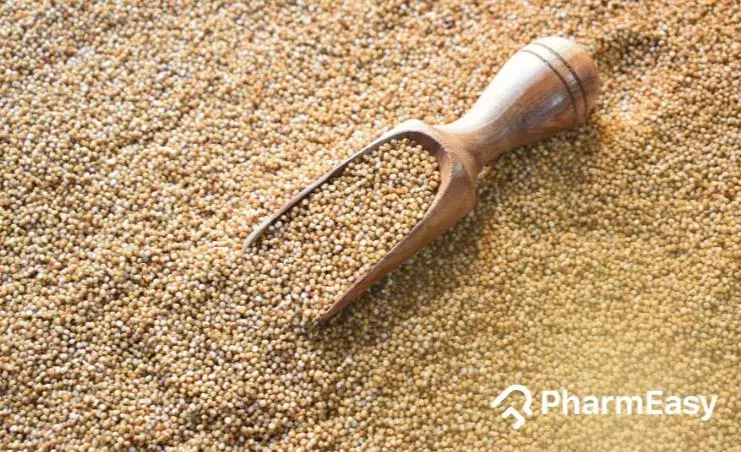Kodo Millets: Uses, Benefits, Side Effects, And More
By Mansi Shah +2 more

Get,

to manage your symptom
Get your,


4 Cr+ families
benefitted

OTP sent to 9988776655



You’ve successfully subscribed to receive
doctor-approved tips on
Whatsapp

Get ready to feel your best.

Hi There,
Download the PharmEasy App now!!


Register to Avail the Offer
Send OTPBy continuing, you agree with our Privacy Policy and Terms and Conditions

Hi There,
Sign up on PharmEasy now!!
Trusted by 4 crore+ families

OTP sent to 9988776655



You have unlocked 25% off on medicines




Code: NU25
By Mansi Shah +2 more
Table of Contents
Kodo millets, botanically known as Paspalum scrobiculatum, is a traditional grain belonging to the Poaceae family. It is often referred to in English as rice grass, ditch millet, or cow grass. Regionally, it is known as araka in Telugu and kodra in Marathi. The grains of kodo millet vary in colour from light red to dark grey and are cultivated annually.
The history of kodo millet cultivation in India dates back approximately 3,000 years. In addition to India, it is also grown in countries such as Russia, China, various parts of Africa, and Japan. Within India, it is primarily cultivated in the states of Madhya Pradesh, Tamil Nadu, Karnataka, Gujarat, and Chhattisgarh.

Among all the millets available, Kodo millets are well known for its resilience to drought and its ability to produce a reasonable yield within a short period. As a result, it holds significant economic importance, particularly in regions where agriculture is challenged by water scarcity. India leads the world in the production of kodo millet
Kodo millets are cultivated in the kharif season (monsoon season) and are available in different varieties, namely Indira kodo, Jawahar kodo, and TNAU. Kodo millets are processed into value-added foods and drinks. While kodo millet is appreciated for its nutritional content and is a staple in many traditional diets, it is important to note that any health-related benefits should be interpreted with caution. The grain may form part of a balanced diet, but it is not intended to diagnose, treat, cure, or prevent any medical condition. Individuals with specific health concerns should consult a qualified healthcare professional before making dietary changes1,2.
Did you know?
Kodo millet is a nutritious grain containing carbohydrates, protein, and dietary fibre. It also provides B-vitamins such as niacin and riboflavin, along with minerals like calcium, iron, and phosphorus. Additionally, it contains natural phytochemicals, including antioxidants and phenolic compounds such as vanillic acid, gallic acid, tannins, and ferulic acid.
Here are the nutritional components of kodo millet per 100 grams2:
In my own viewpoint, this humble grain is not only delicious but also has some surprising health benefits. Kodo millet is believed to have properties that might help in asthma. Not only that it might be beneficial for people suffering from migraine.
Dr. Siddharth Gupta, B.A.M.S, M.D (Ayu)
Scientific studies have explored various characteristics of kodo millet. Some of the observed and researched properties are outlined below:
Let me tell you that these tiny grains might be heroes for your gallbladder! Kodo millets, thanks to their high fibre content, have the potential to avoid the formation of gallstones12.
Dr. Rajeev Singh, BAMS
Some of the potential benefits of kodo millets are described as follows:
Hyperlipidemia is the elevation in lipid components like triglycerides, total cholesterol, and reduced levels of high-density lipoprotein. An animal study4 investigated the potential effects of kodo millet on lipid levels in rats. The findings suggested that kodo millet consumption was associated with reduced levels of total cholesterol, triglycerides, and low-density lipoprotein (LDL), while increasing HDL levels. However, we need more clinical studies to support these claims in humans.
Literature shows that the consumption of kodo millets may have the potential to manage bacterial infections. A review5 conducted noted that kodo millets could inhibit the growth of bacteria like S.aureus, Bacillus cereus, Leuconostoc mesenteroides and Enterococcus faecalis which are organisms associated with infections such as urinary tract infections and diarrhoea. However, we need more studies to support these claims.
Type-2 diabetes is a metabolic disorder characterised by an increase in blood glucose due to decreased production or resistance to a hormone called insulin which regulates blood glucose. A review6 conducted suggested that kodo millets may have the potential to decrease blood glucose levels. This effect is attributed to polyphenols, which inhibit enzymes that break down carbohydrates into simpler sugars and increase blood glucose. Additionally, kodo millets have a low glycaemic index. Certain phenolic compounds found in kodo millets have been studied for their potential to inhibit enzymes such as aldose reductase. This enzyme is involved in the conversion of glucose to sorbitol, an accumulation of which has been linked to diabetic complications, including cataract formation. However, there are not enough studies to support these claims and therefore should only be used under the supervision of a medical professional.
Literature studies have supported the use of kodo millets may possess properties to reduce the risk of cancers. A review study2 indicated that kodo millets may potentially reduce cancer initiation and progression. This anti-cancer effect is attributed to the presence of phenolic acids, phytic acids, and tannins in the grain. However, we need more scientific evidence to support these claims.
Malnutrition is defined as the deficiency, excess, or imbalance in the intake of energy or nutrients. The term malnutrition addresses 3 broad groups of conditions as follows:
Kodo millets are highly nutritious due to the presence of carbohydrates, proteins, dietary fibres, vitamins (like niacin and riboflavin) and minerals (like calcium, iron, and phosphors). Kodo millets are also rich in antioxidants and phenolic compounds like vanillic acid, gallic acid, tannins, and ferulic acid. A review study6 suggested that kodo millets may help manage micronutrient-related malnutrition. Thus, the consumption of Kodo millet may positively impact malnutrition. Though scientific evidence to support these claims is limited, we need more studies to ascertain these claims with better results.
Though there are studies that show the benefits of kodo millets in various conditions, these are insufficient and there is a need for further studies to establish the true extent of the benefits of kodo millets on human health.
In my knowledge, kodo millets with their abundance of nutrients, have been found to have great benefits. They’re not just for filling your plate; they might actually help with inflammation, haemorrhages (excessive bleeding), and general weakness10.
Dr. Smita Barode, B.A.M.S, M.S.
You must consult a qualified doctor before taking any herbal supplements. Do not discontinue or replace an ongoing treatment of modern medicine with an ayurvedic/herbal preparation without consulting a qualified doctor.
I have read in a research paper that the dried ethanol extract of kodo millet husk, when consumed, may have interesting effects on both animals and humans. It has been observed that this extract might cause a calming effect, leading to tranquillity, in various animal species. Additionally, when a human volunteer took the extract, they also experienced possible drowsiness11.
Dr. Anuja Bodhare, B.A.M.S, M.D (Ayu)
A few side effects related to the consumption of kodo millets include:
However, if you experience any adverse reactions to Kodo millet, it is advised to discontinue its intake and immediately contact a doctor or your Ayurvedic physician who has prescribed it. They will be able to guide you appropriately for your symptoms.
Eating kodo millet is okay if taken in moderate amounts. However, general precautions must be followed in the following conditions:
Therefore, you must always seek the advice of your Ayurvedic physician before incorporating kodo millet into your routine, especially if you are on medication. They can provide personalised advice based on your medical history and current treatment plan, helping to avoid any potential interactions.
Kodo millet stands out as a grain with a rich history, impressive nutritional profile, and potential health benefits. Its drought resistance and economic value make it a vital crop, particularly in water-scarce regions. While research continues to explore its medicinal properties, incorporating kodo millet into a balanced diet may support overall health, when used under proper guidance.
Also Read: Puffed Rice: Uses, Benefits, Side Effects By Dr. Rajeev Singh
Kodo millet is called “Kodra” in Marathi.
The different kodo millet varieties available in the market include Indira kodo, Jawahar kodo, and TNAU.
Yes, kodo millets contain certain naturally occurring compounds, known as anti-nutrients, such as phytic acid and polyphenols. These substances reduce the availability of nutritional components and processing methods like soaking will help decrease the level of these anti-nutrients.
Yes, as kodo millet is low in fat content and high in protein and fibre, it increases satiety and reduces overeating, and may help in weight loss.
Contaminated or improperly stored kodo millet may cause kodo poisoning, potentially leading to elevated liver enzymes, nausea, vomiting, and, in severe cases, unconsciousness. The grain
also contains goitrogens, which may interfere with thyroid function and contribute to goitre if consumed excessively without adequate iodine intake.
Disclaimer: The information provided here is for educational/awareness purposes only and is not intended to be a substitute for medical treatment by a healthcare professional and should not be relied upon to diagnose or treat any medical condition. The reader should consult a registered medical practitioner to determine the appropriateness of the information and before consuming any medication. PharmEasy does not provide any guarantee or warranty (express or implied) regarding the accuracy, adequacy, completeness, legality, reliability or usefulness of the information; and disclaims any liability arising thereof.
Comments

Leave your comment...
You may also like
Comments